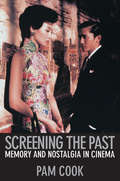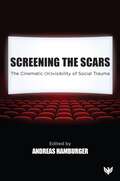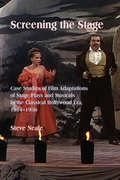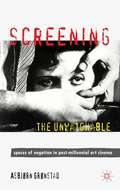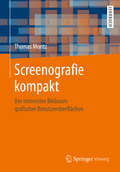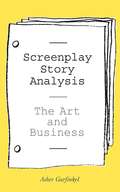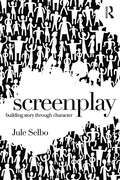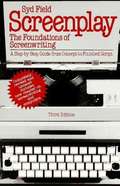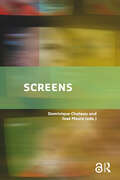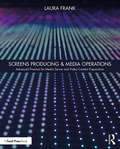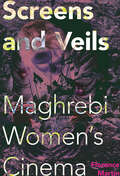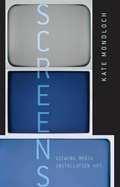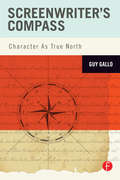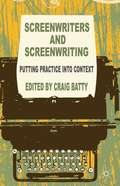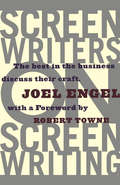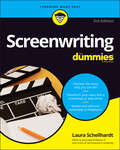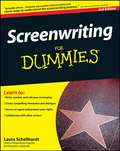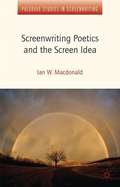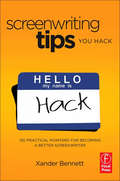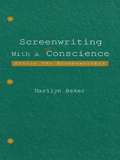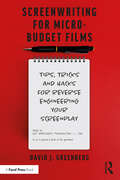- Table View
- List View
Screening the Past: Memory and Nostalgia in Cinema
by Pam CookFrom Mildred Pierce and Brief Encounter to Raging Bull and In the Mood for Love, this lively and accessible collection explores film culture's obsession with the past, offering searching and provocative analyses of a wide range of titles. Screening the Past engages with current debates about the role of cinema in mediating history through memory and nostalgia, suggesting that many films use strategies of memory to produce diverse forms of knowledge which challenge established ideas of history, and the traditional role of historians. Classic essays sit side by side with new research, contextualized by introductions which bring them up to date, and provide suggestions for further reading as the work of contemporary directors such as Martin Scorsese, Kathryn Bigelow, Todd Haynes and Wong Kar-wai is used to examine the different ways they deploy creative processes of memory. Pam Cook also investigates the recent history of film studies, reviewing the developments that have culminated in the exciting, if daunting, present moment. The result is a rich and stimulating volume that will appeal to anyone with an interest in cinema, memory and identity.
Screening the Scars: The Cinematic (In)visibility of Social Trauma
by Andreas HamburgerWith contributions from Ozcan Alper, Damir Arsenijevic, Friederike Bassenge, Alen Drljevic, Andreas Hamburger, Camellia Hancheva, Dzenana Husremovic, Lars Kraume, Dijana Jelaca, Ajna Jusic, Cem Kaptanoglu, Stephan Komandarev, Maida Koso-Drljevic, Nadia Kozhouharova, Gamze Ozcurumez, Tatjana Petzer, Vivian Pramataroff-Hamburger, Goran Radovanovic, Biljana Stankovic, Svetlozar Vassilev, and Jasmila zbanic. In the last decade, the concept of trauma has experienced a surprising boom in sociological and media debates. In a culture of outrage, blanket narratives of victimhood often overshadow the concrete, known social violations and their observable real economic and psychological consequences. The aim of this volume is to reflect on this shift in discourse and to compare it with the concrete historical backgrounds and psychosocial constitutions of countries that have been haunted by social trauma in different ways. In discussing feature films from Germany and four Balkan countries, the book presents the distinct social-traumatic histories, how they are negotiated in different societies, and the motifs cinema uses to narrate them. The award-winning films featured are Sadilishteto [The Judgement], Grbavica [Esma's Secret - Grbavica], Muskarci ne placu [Men Don't Cry], Enklava [Enclave], Der Staat gegen Fritz Bauer [The People vs. Fritz Bauer], and Sonbahar [Autumn]. The individual film analyses are each accompanied by interviews with the filmmakers and introduced by overarching themes, the role of cinema as a place of social understanding in a post-traumatic society, and the methodology of film analysis. With contributions from the worlds of film, psychoanalysis, activism, psychiatry, film studies, literary and cultural studies, psychology, trauma studies, philosophy, psychotherapy, and human relations, this book has a broad appeal. It is a must-read for those looking for a deeper insight into social trauma and the impact of sociocultural factors, shown so clearly through the filmmaker's lens.
Screening the Stage: Case Studies of Film Adaptations of Stage Plays and Musicals in the Classical Hollywood Era, 1914-1956
by Steven NealeIntroduced by a comprehensive account of the factors governing the adaptation of stage plays and musicals in Hollywood from the early 1910s to the mid-to-late 1950s, Screening the Stage consists of a series of chapter-length studies of feature-length films, the plays and musicals on which they were based, and their remakes where pertinent. Founded on an awareness of evolving technologies and industrial practices rather than the tenets of adaptation theory, particular attention is paid to the evolving practices of Hollywood as well as to the purport and structure of the plays and stage musicals on which the film versions were based. Each play or musical is contextualized and summarized in detail, and each film is analyzed so as to pinpoint the ways in which they articulate, modify, or rework the former. Examples range from dramas, comedies, melodramas, musicals, operettas, thrillers, westerns and war film, and include The Squaw Man, The Poor Little Rich Girl, The Merry Widow, 7th Heaven, The Cocoanuts, Waterloo Bridge, Stage Door, I Remember Mama, The Pirate, Dial M for Murder and Attack.
Screening the Unwatchable
by Asbjørn GrønstadTracing the rise of extreme art cinema across films from Lars von Trier's The Idiots to Michael Haneke's Cach#65533;, Asbj#65533;rn Gr#65533;nstad revives the debate about the role of negation and aesthetics, and reframes the concept of spectatorship in ethical terms.
Screening the World: Global Development of the Multiplex Cinema
by Stuart HansonThis book charts the development of the multiplex cinema as the pre-eminent form of film exhibition across the world. Going from its origins in the USA in the 1960s to its expansion overseas from the mid-1980s across Europe, Australia and other parts of Asia-Pacific, the book considers the emergence of a series of initially regional, then national and then international exhibition circuits. However, more than a consideration of US overseas expansion on the part of companies, this book examines the hegemony of the multiplex as a cultural and business form, arguing for its significance as a phenomenon that has transcended national and global boundaries and which has become the predominant venue for film viewing. Implicit in this analysis is a recognition of the domination of US media multi-nationals and Hollywood cinema, and the development of the multiplex cinema as symbolic of the extension and maintenance of the USA’s cultural and economic power. With case studies ranging from European countries such as Belgium, France, Germany and The Netherlands, to Pacific-Asian countries such as Australia, China, Japan and South Korea, this book is the first to explore the development of multiplexes on a global scale.
Screenografie kompakt: Der immersive Bildraum grafischer Benutzeroberflächen
by Thomas MoritzDieses Buch behandelt die Screenografie von grafischen Benutzeroberflächen basierend auf einem didaktisch strukturierten Lehrprogramm, dessen Kapitel inhaltlich aufeinander aufbauen und jeweils in einem zusammenfassenden Fazit enden. Nach einer einführenden thematischen Motivation werden wahrnehmungspsychologische und kommunikationswissenschaftliche Grundlagen des Systemischen Designs erläutert, dessen Spezifik für die systematische Entwicklung grafischer Benutzeroberflächen essentiell ist. Im Kontext immersiver Raumnutzung wird u.a. illustriert, wie ein Screen morphologisch in kleinere geometrische Einheiten unterteilbar ist, die als visuelles Ganzes die ideale Basis für ein visuelles Gestaltungsraster bilden, welches den immersiven Bildraum strukturiert und organisiert. Es werden nutzerspezifische Farbgebungen für ein visuelles Ambiente aufgezeigt, das einem speziellen Nutzernaturell entspricht, da es auf Erfahrungen mit natürlichen Umgebungen basiert und über alle geografischen und ethnologischen Grenzen hinweg stimuliert und zur interaktiven Nutzung motiviert.
Screenografie kompakt: Der immersive Bildraum grafischer Benutzeroberflächen
by Thomas MoritzDieses Lehrprogramm zur systematischen Gestaltung eines interaktiv nutzbaren Bildschirms (Screen) erläutert wahrnehmungspsychologische und kommunikationswissenschaftliche Grundlagen, die für das Systemische Design grafischer Benutzeroberflächen (Graphical User Interfaces) relevant sind. Im Kontext interaktiver Raumnutzung wird illustriert, wie die Bildschirmfläche morphologisch in Form eines visuellen Gestaltungsrasters (Visual Design Pattern) zu gliedern ist, das den immersiven Bildraum der grafischen Benutzeroberfläche strukturiert und die interaktive Nutzung erleichtert. Es werden mögliche Farbkombinationen für ein visuelles Ambiente definiert, deren Wirkungsweise auf natürlichen Erfahrungswerten basiert und somit einem speziellen Nutzernaturell entspricht, dessen Charakteristika weltweit identisch sind.
Screenografie kompakt: Der immersive Bildraum grafischer Benutzeroberflächen
by Thomas MoritzDieses Lehrprogramm zur systematischen Gestaltung eines interaktiv nutzbaren Bildschirms (Screen) erläutert wahrnehmungspsychologische und kommunikationswissenschaftliche Grundlagen, die für das Systemische Design grafischer Benutzeroberflächen (Graphical User Interfaces) relevant sind. Im Kontext interaktiver Raumnutzung wird illustriert, wie die Bildschirmfläche morphologisch in Form eines visuellen Gestaltungsrasters (Visual Design Pattern) zu gliedern ist, das den immersiven Bildraum der grafischen Benutzeroberfläche strukturiert und die interaktive Nutzung erleichtert. Es werden mögliche Farbkombinationen für ein visuelles Ambiente definiert, deren Wirkungsweise auf natürlichen Erfahrungswerten basiert und somit einem speziellen Nutzernaturell entspricht, dessen Charakteristika weltweit identisch sind. In der dritten Auflage wird der historische Kontext im Aufbau visueller Gestaltungsraster analysiert. Die Abkehr vom realistisch gemalten Tafelbild ermöglichte neue Formensprachen und Kunstformen auf Grundlage der systematischen Konstruktion analog der Gestaltungslehre des Bauhauses. Die tragende Rolle von Mathematik und Geometrie im künstlerischen Schaffensprozess „Konkreter Kunst&“ wird durch zahlreiche Beispiele illustriert und um beispielhafte Gestaltungslösungen aus dem Bereich des "Absoluten Films" ergänzt.
Screenplay Story Analysis: The Art And Business
by Asher GarfinkelSometimes it seems like everybody's writing a screenplay. But who reads those screenplays? Professional story analysts, that's who. Screenplay Story Analysis explains exactly how to become a professional story analyst.<P><P> Along with a basic how-to on writing a story analysis-or "coverage"-this book explains the techniques and thought processes involved in reading and evaluating a screenplay. Get familiar with terms, techniques, and general story elements. Master standard coverage format and content. Find guidelines for practicing coverage and getting work as a professional story analyst. With a foreword by Craig Perry, producer of American Pie, Final Destination, and other successful movies, and quotes from industry pros from top entertainment companies including ABC and Paramount Pictures, this is the essential guide for breaking into the business.
Screenplay: Building Story Through Character
by Jule SelboScreenplay: Building Story Through Character is designed to help screenwriters turn simple or intricate ideas into exciting, multidimensional film narratives with fully-realized characters. Based on Jule Selbo’s unique 11-step structure for building story through characters, the book teaches budding screenwriters the skills to focus and shape their ideas, turning them into stories filled with character development, strong plot elements based on obstacles and conflicts, and multifaceted emotional arcs. Using examples and analysis from classic and contemporary films across a range of genres, from The Godfather to Guardians of the Galaxy, Selbo’s Screenplay takes students inside the scriptwriting process, providing a broad overview for both beginners and seasoned writers alike. The book is rounded out with discussion questions, writing exercises, a guide to the business of screenwriting, in-depth film breakdowns, and a glossary of screenwriting terms.
Screenplay: The Foundations of Screenwriting (Third Edition)
by Syd FieldHere are easily understood guidelines to make film writing accessible to novices and to help practiced writers improve their scripts. Syd Field pinpoints the structural and stylistic elements essential to every good screenplay. He presents a step-by-step, comprehensive technique for writing the script that will succeed. Why are the first ten pages of your script crucially important? How do you collaborate successfully with someone else? How do you adapt a novel, a play, or an article into a screenplay? How do you market your script?
Screens (The Key Debates: Mutations and Appropriations in European Film Studies)
by José Moure Dominique ChateauWe live in an era of screens. No longer just the place where we view movies, or watch TV at night, screens are now ubiquitous, the source of the majority of information we consume daily, and a crucial component of our basic interactions with colleagues, friends, and family. This transformation has happened almost without us realizing it-and certainly without the full theoretical and intellectual analysis it deserves. Screens brings together scholars from a variety of disciplines to analyse the growing presence and place of screens in our lives today. They tackle such topics as the archaeology of screens, film and media theories about our interactions with them, their use in contemporary art, and the new avenues they open up for showing films and other media in non-traditional venues.
Screens Producing & Media Operations: Advanced Practice for Media Server and Video Content Preparation
by Laura FrankMedia servers have established themselves as the dominant video playback tool for live events; however, the practice of delivering content to these systems and the structure of the media operations team is still evolving. This book outlines a workflow for video content delivery and describes team communication that can be applied to any entertainment production including: television specials, concert touring, corporate events, theater, as well as special events, film, large audience marketing events, and multi-screen permanent installations. This workflow is hardware and software independent, designed to evolve with future technologies as they become established in the field of multi-screen production, and has been proven professionally by the author and her peers over a decade of productions. The methodology presented will provide insights beneficial to students and current practitioners of media server technology, screens producers, and video content developers. Using real world examples of internationally recognized productions, a foundation is laid for best practices in Media Operations. Additional content, including full-color versions of the images inside the book, is available online.
Screens and Veils: Maghrebi Women's Cinema (New Directions In National Cinemas Ser.)
by Florence MartinExamined within their economic, cultural, and political context, the work of women Maghrebi filmmakers forms a cohesive body of work. Florence Martin examines the intersections of nation and gender in seven films, showing how directors turn around the politics of the gaze as they play with the various meanings of the Arabic term hijab (veil, curtain, screen). Martin analyzes these films on their own theoretical terms, developing the notion of "transvergence" to examine how Maghrebi women's cinema is flexible, playful, and transgressive in its themes, aesthetics, narratives, and modes of address. These are distinctive films that traverse multiple cultures, both borrowing from and resisting the discourses these cultures propose.
Screens: Viewing Media Installation Art (Electronic Mediations #30)
by Kate MondlochMedia screens—film, video, and computer screens—have increasingly pervaded both artistic production and everyday life since the 1960s. Yet the nature of viewing artworks made from these media, along with their subjective effects, remains largely unexplored. Screens addresses this gap, offering a historical and theoretical framework for understanding screen-reliant installation art and the spectatorship it evokes. Examining a range of installations created over the past fifty years that investigate the rich terrain between the sculptural and the cinematic, including works by artists such as Eija-Liisa Ahtila, Doug Aitken, Peter Campus, Dan Graham, VALIE EXPORT, Bruce Nauman, and Michael Snow, Kate Mondloch traces the construction of screen spectatorship in art from the seminal film and video installations of the 1960s and 1970s to the new media artworks of today&’s digital culture. Mondloch identifies a momentous shift in contemporary art that challenges key premises of spectatorship brought about by technological objects that literally and metaphorically filter the subject&’s field of vision. As a result she proposes that contemporary viewers are, quite literally, screen subjects and offers the unique critical leverage of art as an alternative way to understand media culture and contemporary visuality.
Screenwriter's Compass: Character As True North
by Guy GalloEver watch a movie, and despite great production value, fantastic action sequences, a great cast, etc, you come away thinking-I just didn't buy it. Chances are it was because you didn't care about the characters. Screenwriter's Compass presents a new way of approaching screenwriting, examining how effective screen storytelling must be grounded in the vivid imagining and presentation of character. Screenwriter's Compass will not offer formulas to follow but instead will give you the tools needed to chart your own path to screenwriting success. It details useful ways of thinking about writing, as well as practical ideas and concepts to help you discover the unique geography of your own imagination and navigate the problems posed by the struggle to express vision, agenda, and story. You'll learn how to root your writing in motivation and voice, to create screenplays that seduce and make your reader lean forward, and, most importantly, identify with your characters.
Screenwriters and Screenwriting
by Craig BattyScreenwriters and Screenwriting is an innovative, fresh and lively book that is useful for both screenwriting practice and academic study. It is international in scope, with case studies and analyses from the US, the UK, Australia, Japan, Ireland and Denmark. The book presents a distinctive collection of chapters from creative academics and critical practitioners that serve one purpose: to put aspects of screenwriting practice into their relevant contexts. Focusing on how screenplays are written, developed and received, the contributors challenge assumptions of what 'screenwriting studies' might be, and celebrates the role of the screenwriter in the creation of a screenplay. It is intended to be thought provoking and stimulating, with the ultimate aim of inspiring current and future screenwriting practitioners and scholars.
Screenwriters on Screen-Writing: The Best in the Business Discuss Their Craft
by Joel EngelBefore any lights, camera, or action, there's the script--arguably the most important single element in filmmaking, and Screenwriters on Screen-Writing introduces the men and women responsible for the screenplays that have produced some of the most successful and acclaimed films in Hollywood history. In each interview, not only do the writers explore the craft and technique of creating a filmic blueprint, but they recount the colorful tales of coming up in the ranks of the movie business and of bringing their stories to the screen, in a way that only natural-born storytellers such as themselves can. These and other screenwriters have garnered the attention of the movie-going population not only with their words, but with headlines announcing the sales of their scripts for hundreds of thousands and sometimes millions of dollars.Anyone interested in writing, making, or learning about movies will enjoy reading this fascinating behind-the-scenes compendium that brings together some of the most prominent and talented screenwriters in modern-day filmmaking. Screenwriters interviewed include:Bruce Joel Rubin (Ghost), Ernest Lehman (North by Northwest, Who's Afraid of Virginia Woolf?), Amy Holden Jones (Indecent Proposal), Ted Tally (The Silence of the Lambs), Horton Foote (To Kill a Mockingbird, Tender Mercies), Andrew Bergman (The In-Laws), Caroline Thompson (Edward Scissorhands), Richard LaGravenese (The Fisher King), and Robert Towne (Chinatown, Shampoo).
Screenwriting For Dummies
by Laura SchellhardtSuspend your disbelief—you can make it as a screenwriter Behind every blockbuster film and binge-worthy show, there’s a screenwriter—and that writer could be you! Turn your brainstorming sessions into dynamic scripts with the help of Screenwriting For Dummies. Create believable worlds with relatable characters, gripping dialogue, and narrative structures that will keep even the showbiz bigwigs on the edge of their seats. Once you’ve polished your product, it’s time to bring it to market. This book is full of advice that will help you get eyes on your screenplays so you can sell your work and find success as a screenwriter. From web series to movie musicals to feature films, this book shows you how to develop and hone your craft. Learn to think like a screenwriter and turn story ideas into visually driven, relatable scripts that will get noticed Study the elements of a story, like plot structure (beginning, middle, and end) and characterization (wait, who’s that, again?) Hop over the hurdle of writer’s block, and tackle other obstacles that stand in the way of your scriptwriting career Get insider insight into finding an agent and meeting with studio execs, plus alternative markets for your finished work This updated edition covers the latest trends and opportunities—and there are lots of them—for today’s writers. Let Dummies help you map out your story and put your script on the road to production. Thank us when your work goes viral!
Screenwriting For Dummies, 2nd Edition
by Laura Schellhardt John LoganWrite a great script and get it into the hands of the Hollywood players! So you want to be a screenwriter? Whether you want to write a feature film or a TV script or adapt your favorite book, this friendly guide gives you expert advice in everything from creating your story and developing memorable characters to formatting your script and selling it to the studios. You get savvy industry tips and strategies for getting your screenplay noticed! The screenwriting process from A to Z -- from developing a concept and thinking visually to plotline, conflicts, pacing, and the conclusion Craft living, breathing characters -- from creating the backstory to letting your characters speak to balancing dialogue with action Turn your story into a script -- from developing an outline and getting over writer's block to formatting your screenplay and handling rewrites Prepare for Hollywood -- from understanding the players and setting your expectations to polishing your copy and protecting your work Sell your script to the industry -- from preparing your pitch and finding an agent to meeting with executives and making a deal Open the book and find: The latest on the biz, from entertainment blogs to top agents to box office jargon New story examples from recently released films Tips on character development, a story's time clock, dramatic structure, and dialogue New details on developing the nontraditional screenplay -- from musicals to animation to high dramatic style Expanded information on adaptation and collaboration, with examples from successful screenwriting duos
Screenwriting Fundamentals: The Art and Craft of Visual Writing
by Irv BauerScreenwriting Fundamentals: The Art and Craft of Visual Writing takes a step-by-step approach to screenwriting, starting with a blank page and working through each element of the craft. Written in an approachable anecdote-infused style that’s full of humor, Bauer shows the writer how to put the pieces together, taking the process of screenwriting out of the cerebral and on to the page. Part One of the book covers character, location, time-frame and dialogue, emphasizing the particularity in writing for a visual medium. Part Two of the book focuses on the narrative aspect of screenwriting. Proceeding incrementally from the idea and story outline, through plotting and writing the treatment, the workshop-in-a-book concludes with writing the First Draft. A unique emphasis on the visual elements of storytelling because the camera is always present—the screenplay must act as a guide for the director and the editor. A "workshop in a book" approach that walks the reader step-by-step through a screenplay—focusing on character, location, time frame, visual components, and transitions—with plenty of exercises that generate material for the narrative writing process. A process-oriented approach, combined with a lighthearted tone and approachable style, that allows the reader to ease into the daunting task of writing a First Draft and takes them all the way through to the end— First Draft in hand.
Screenwriting Poetics and the Screen Idea
by Ian W. MacdonaldA new, original investigation into how screenwriting works; the practices, creative 'poetics' and texts that serve the screen idea. Using a range of film, media and creative theories, it includes new case studies on the successful ITV soap Emmerdale, Hitchcock's first major screenwriter and David Lean's unfinished film, Nostromo.
Screenwriting Tips, You Hack: 150 Practical Pointers for Becoming a Better Screenwriter
by Xander BennettScreenwriting Tip #99Voice-over usually feels like scaffolding. You know-something you left in there when you were constructing the first draft, but really should have torn out after it served its purpose. Screenwriting Tip #120Always remember that funny trumps everything. Your script could be written in crayon with your name spelled wrong on the cover, but if it's genuinely funny, none of that matters. Screenwriting Tip #156The easiest way to write kick-ass protagonists is to make them incredibly good at what they do. Confused at the outline stage? Stuck in the swamp of Act Two? Don't know who your protagonist is or where she's going?You might feel like a hack. But don't worry-you're not alone. Even the most experienced writers feel like this at times. Sometimes we just need a few short pointers and reminders to set us on the path again.Xander Bennett worked as a script reader in the trenches of Hollywood, reading and covering hundreds of mediocre screenplays. After months of reading about heroic Sea World trainers, transgendered circus detectives and crime-fighting chupacabras, he couldn't take it any more. Xander started a blog called 'Screenwriting Tips, You Hack', a place designed to provide short, witty tips on screenwriting for amateur writers all the way up to journeymen scribes.This book is the evolution of that blog. Dozens of the best scripts (along with many brand-new ones) have been expanded into bite-sized chapters full of funny, insightful, highly usable advice. Let Xander's pain be your gain as you learn about the differences between film and television structure, how to force yourself to write when you really don't want to, and why you probably shouldn't base your first spec script around an alien invasion.
Screenwriting With a Conscience: Ethics for Screenwriters
by Marilyn BekerScreenwriting With a Conscience: Ethics for Screenwriters is for screenwriters who care deeply about what they write; who are aware that movie images matter and can influence audiences; and who want to create meaningful screenplays that make powerful statements while entertaining and winning over audiences. A user-friendly guide to ethical screenwriting, this book makes the case that social responsibility is endemic to public art while it emphatically champions First Amendment rights and condemns censorship.In this dynamic and practical volume, author Marilyn Beker provides methods for self-assessment of values, ideas, and ethical stances, and demonstrates the application of these values to the development of plot, character, and dialogue. Screenwriters are introduced to ethical decision making models and shown--through specific film examples--how they can be utilized in plot and character development. In addition, specific techniques and exercises are supplied to help screenwriters determine the difference between "good" and "evil," to write realistic and compelling characters based on this determination, and to present "messages" and write dialogue powerfully without preaching. This book also puts forth a livable work philosophy for dealing with the ethics of the screenwriting business, and presents a viable personal philosophy for surviving in the screenwriting world.Screenwriting With a Conscience: Ethics for Screenwriters is an indispensible, dynamic guide for the ethics-conscious screenwriter. It is intended for screenwriters at the student and professional level, and is appropriate for beginning to graduate screenwriting courses in film and English programs, and for film courses dealing with Ethics in the Media.
Screenwriting for Micro-Budget Films: Tips, Tricks and Hacks for Reverse Engineering Your Screenplay
by David J GreenbergScreenwriting for micro-budget films can present its own challenges and this book takes the reader through all the considerations that need to be made to write an effective screenplay for a low-budget film. Drawing on his own experience, case studies from films such as Primer, Coherence and Reservoir Dogs, as well as the perspectives of working screenwriters such as Joe Swanberg and Alex Ross-Perry, Greenberg explores common pitfalls screenwriters face and suggests practical solutions. This book lays the groundworks of the realities of low-budget filmmaking and also talks through the practical aspects, such as story structure and genre considerations. Greenberg makes the process of writing a screenplay for a low-budget film accessible and creative, allowing student and independent filmmakers to tailor their writing for their films. This book is ideal for aspiring screenwriters, independent filmmakers and students of screenwriting.
